449 Search Results for VISUAL SUPPORTS
January 30, 2013
by Robin Parker -
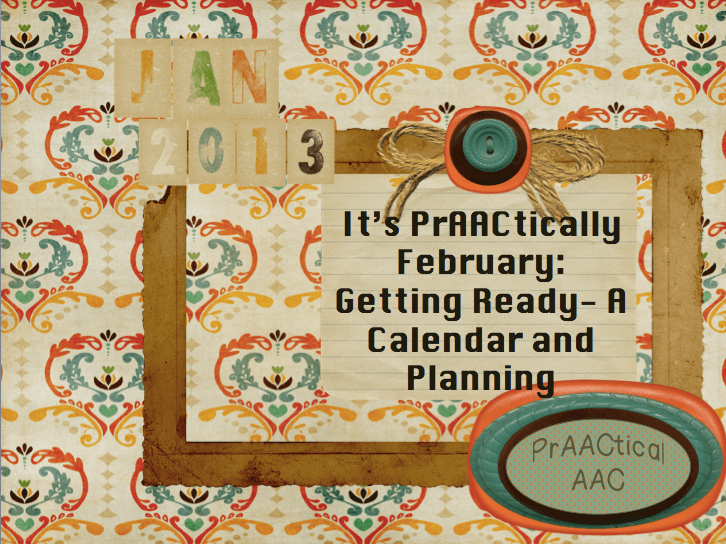
January is (was) a fairly crazy and busy month for us. After a late back to school week, the CARD Conference, the Dan Marino Foundation WalkAbout Autism, and ATIA Conference (hope to see you there), we got a bit of a late start on a few things. To stay ahead of ourselves, we want to end January by being ready for February…… For February, we have a calendar for incorporating AAC into everyday activities (it goes with yesterday’s post 28 things to do). Feel free to print out and share and use anyway you want to promote PrAACtical AAC. A PDF version (free) can be found at our Teachers Pay Teachers site. Our new Strategy of the Month (on Saturday) will focus on Communication & Language Beyond Requesting. There are no pre-requisites to learning and being immersed in ALL of the reasons to communicate (communication functions). For some learners, it... [Read More...]
January 15, 2013
by Carole Zangari -
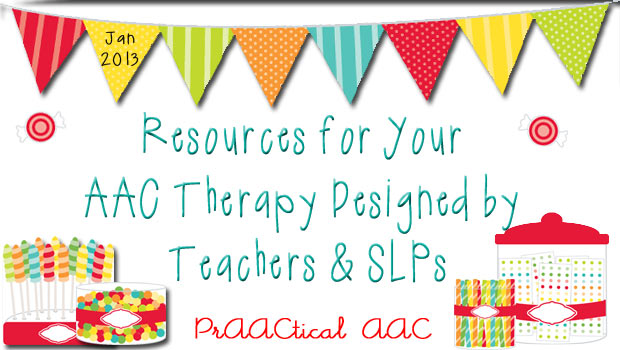
2012 was certainly the year that saw an explosion of SLPs and teachers authoring materials that they offer for sale. TeachersPayTeachers (TpT) is one of several sites that became popular this year and is credited with giving a huge boost to the movement. Here are some of prAACtical interest. Kate Ahern’s Core Word Boards: This set of communication boards can be a big timesaver for anyone who wants to implement a core word approach and needs help in getting set up with some initial materials. (17 pp) Fun for Learning’s visual support with a Star Wars Theme. Use this (or one of her other thematic kits) to customize picture schedules and supports based on the learner’s area of interest. (Free) Working on semantics? This PowerPoint template for making vocabulary teaching supports from Jerilyn can be used to provide practice. (Free) Teaching interrogatives is something that most of us don’t... [Read More...]
January 11, 2013
by Carole Zangari -
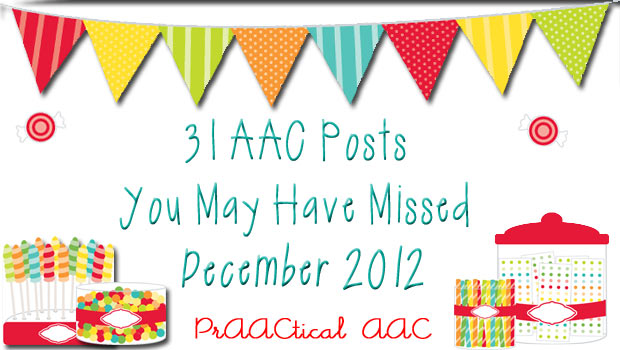
PrAACtically Thinking Happy New Year Let’s Cook: It’s PrAACtically the New Year! 10 Resources for Planning and Designing Communication Books Why We Love AAC Language Experience Activities AAC Vocabulary Instruction Round-Up Beyond Good Intentions: Thoughts on PrAACtical Supports for AAC Families No Words: “We’re Hurting, Too” Quick Start Communication Book Pages Talk About Me, Too: AAC and Visual Strategies for Significant Challenges The PrAACtical Side of Giving: Random AACts of Kindness Hello, Holiday! 10 Great Apps to Gift Do It My Way: Personalizing Communication Books 31 AAC Posts You May Have Missed, November 2012 Why We Love Sequential Message Devices/Apps Strategy of the Month The PrAACtical Power of Communication Books Organizing Vocabulary for Communication Books: Getting Started Communication Books: Making Decisions About Format The Communication Book is Ready: Now What? PrAACtically Personal: Individualizing Communication Books Video of the Week Making Libraries Inclusive Inclusive Libraries, Part 2 Why Use AAC? Why... [Read More...]
January 4, 2013
by Robin Parker -
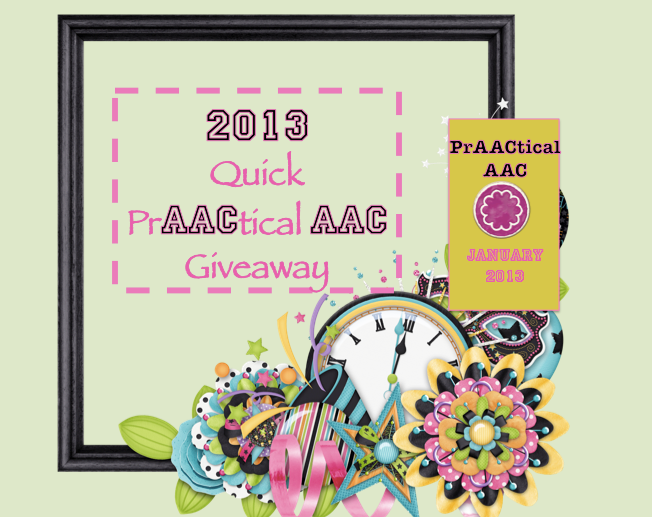
We are so excited for a great 2013 and we have 2 AAC Giveaway Winners! Congratulations! Thank you to everyone who participated and to Therapy Box Apps Scene & Heard- (Scene & Heard) & Enabling Devices/Toys for Special Children #1 Enabling Devices/Toys for Special Children has generously donated a 4-Compartment Scanning Communicator. Please show your appreciation of Enabling Devices by visiting and liking their Facebook page. #2 Scene & Heard- We have one code for the Scene & Heard AAC app that supports multiple languages through voice recordings and supports switch scanning. Scene & Heard takes a visual scene approach to AAC and we are so appreciative to T-Box Apps for donating their app for this giveaway. Don’t forget to show your appreciation by liking their Facebook Page. Enter the Giveaway- How Does It Work? We use Rafflecopter to administer the giveaways. All entries made through there will be counted toward our drawings. Enter now and everyday until... [Read More...]
December 22, 2012
by Robin Parker -
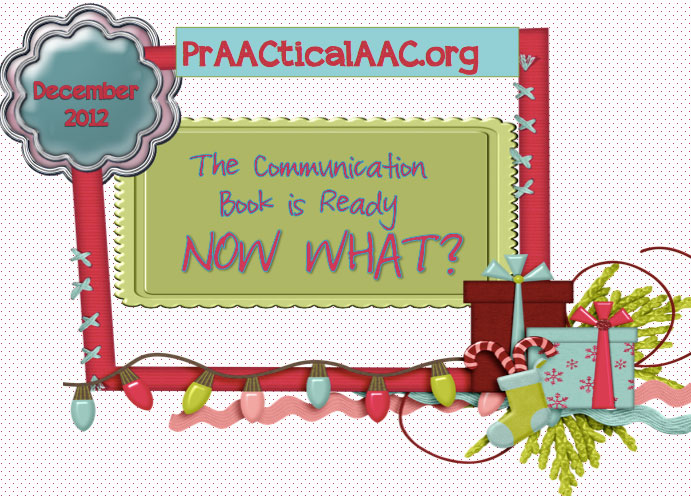
The Communication Book is Ready… Now What? The fun begins…. Yes, we really do think that TEACHING a learner to USE the communication book is FUN. We get to participate in lots of meaningful language experiences, we get to be creative, we get to watch language blossom, and we get to be surprised by the communication competence ALL of our learners show us after prAACtice, prAACtice, and for some more prAACtice . The best way to get started with communication book teaching is to begin by trying out different teaching tips, strategies, and resources and find out what works best. Each communication dyad (communicator & communication partner) is different so the combination of strategies that will work will vary but at the core of the teaching process, there should be fun, motivation, and of course progress. STRATEGIES and CONSIDERATIONS Aided Language Input (ALI)– We can not say enough about... [Read More...]
October 30, 2012
by Carole Zangari -
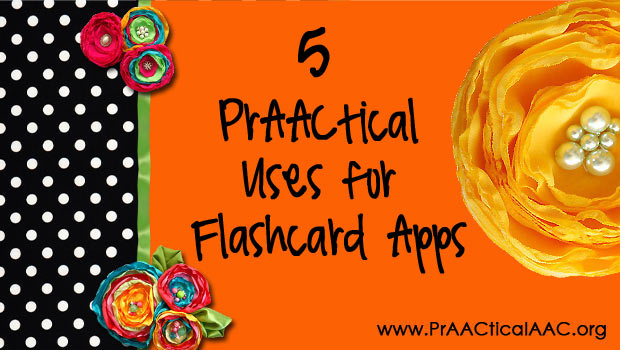
We love AAC intervention that begins and ends with a context that is meaningful to the learner. Not only is contextually relevant therapy more engaging and fun for the learner (thus, easier on the clinician!) but it promotes generalization to real-world contexts. So we’ve never been terribly fond of therapy that uses flash cards, or, more recently, the digital versions on iOS or Android devices. It’s a shame, really. There are a lot of those kinds of apps, and many of them have great graphics. That got us to starting thinking: What could we use them for that improves real communication and AAC learning? PrAACtical Uses for Flashcard Apps Make a Mini Schedule: Lots of people with AAC needs use paper-based picture schedules that depict the activities they do throughout the day. A flashcard app could be used in conjunction with those to show the steps or parts of an... [Read More...]
October 27, 2012
by Robin Parker -
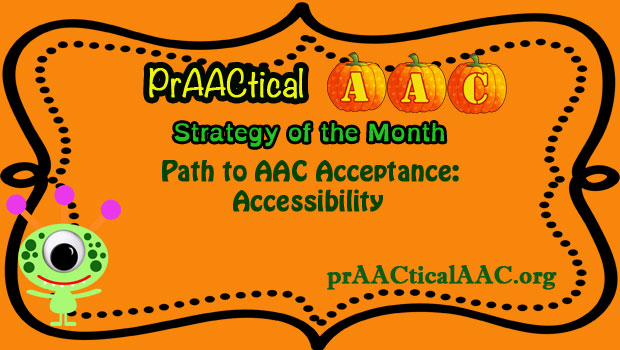
It is AAC Awareness Month and everyone has really been spreading the word and helping to build AAC acceptance. Participation barriers continue to prevent full AAC acceptance. In order to help combat these obstacles it is necessary to talk about them, deconstruct them, and attempt to build solutions. So after going over attitudinal barriers and information barriers, we need to discuss accessibility barriers. It’s a shame that there are so many barriers to making AAC work, but we know that with awareness comes improvement. Barriers of accessibility can be about motor, sensory, cognitive, literacy, or communication/language issues. For this discussion though the focus is on accessing AAC to learn a comprehensive language in ALL modalities (i.e., talking, listening, reading, & writing). The prevention of access to a comprehensive system is usually tied in to assumptions about cognitive and literacy skills. Although it seems that most professionals realiize that there... [Read More...]
October 25, 2012
by Robin Parker -
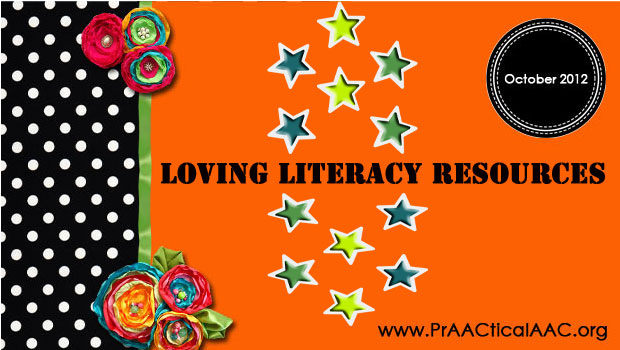
For AAC Awareness Month, we would be remiss if we did not think about literacy. It is a form of communication and language that supports AAC use. Sometimes literacy is difficult for our students, other times it is actually easier and it helps conversational communication and even natural speech. Either way, reading, writing, talking, and listening (understanding) are all modalities of language. There are so many great resource lists for supporting literacy: Jane Farrall’s Letter of the Week: Resources for Older Students, Spectronics Apps for Literacy Support, Melissa Taylor’s 24 Educational iPad Apps for Kids in Reading and Writing, and 25 Great Children’s Apps to Stimulate Literacy, Learning, & Creativity just to name a few. We wanted to share a few additional resources for literacy with general education apps that approach reading through fun with words. And any literacy discussion could not be complete without some seriously great literacy information, theory, and supports... [Read More...]
October 20, 2012
by Carole Zangari -
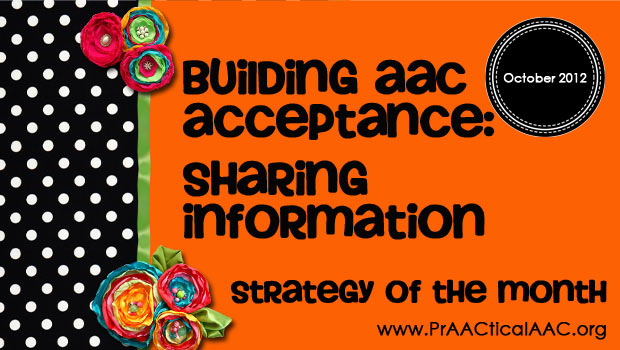
While there are certainly attitudinal barriers to AAC, it’s also true that sometimes the people we are trying to influence just need more information. Sounds simple, right? Not exactly. Especially when we consider these factors. Adult learners prefer to chart their own course to learning new things rather than have others lay that out for them. Our behaviors are most likely to change when we discover solutions for ourselves, as opposed to following directions that others give to us. We have a limited amount of time to guide others to the information they need. Here are some things that have worked for us. Develop a bank of educational materials that pertain to the topics that you face most often in your clinical work. Create resource files for general topics, such as the empirically-supported benefits of AAC, and specific topics, such as the evidence base for using SGDs with individuals who... [Read More...]
September 16, 2012
by Carole Zangari -
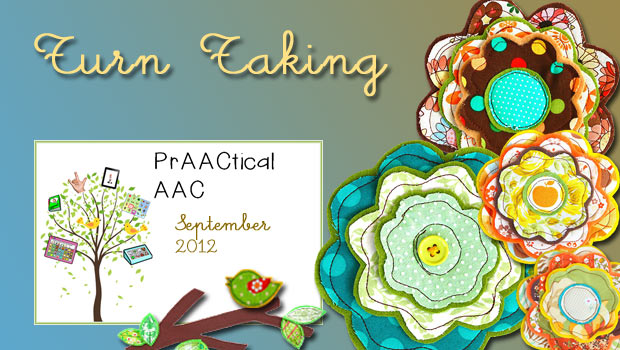
We’re always looking for new ways to represent things visually. Today, we’re sharing an idea from Amy Laurent on helping children take turns. You can view a video explaining the strategy she uses and download the visual support here.









